- Faculty News
- Student News
- Lab News
- Publications
- Meetings and Presentations
- Outreach
- Grants
- Announcements
- About This Newsletter
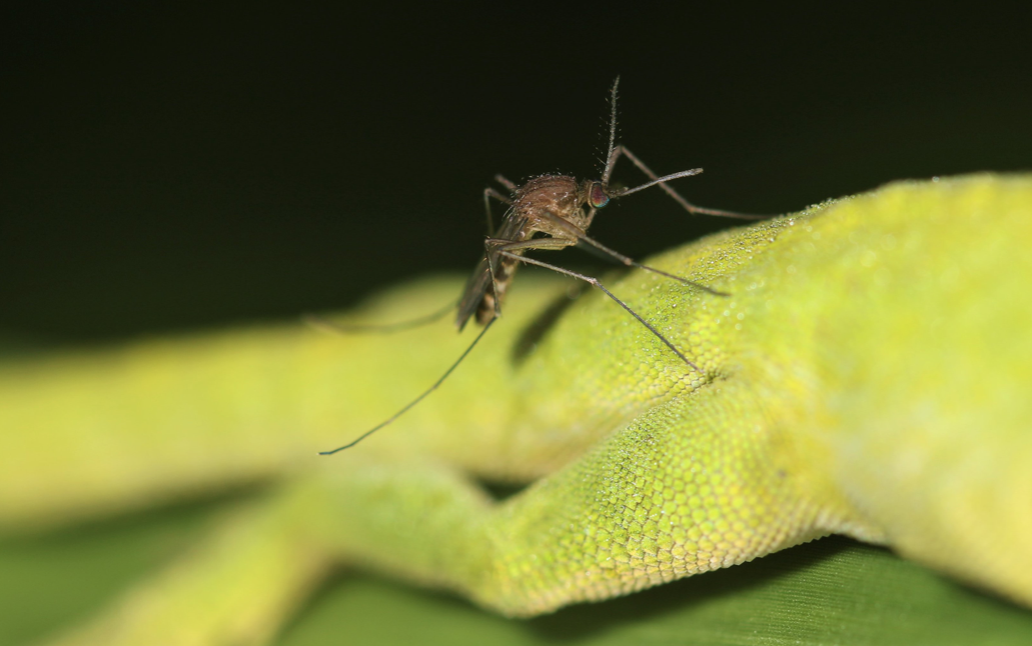
ABOVE: Mosquito, Culex nigripalpus on a green anole, Anolis carolinensis. Photo taken by graduate student Kristin Sloyer.

ABOVE: Dr. Bryony Bonning along with colleagues Dr. Lukasz Stelinski, Dr. Choaa El-Mohtar, Dr. Nabil Killiny, Dr. Manjul Dutt, and Dr. Monique Rivera, UC Riverside, and Citrus Research and Education Center were awarded a nearly $1.5 million grant from USDA-NIFA’s Emergency Citrus Disease Research & Extension program to evaluate the combined impacts of gene silencing RNAs and bacterial pesticidal proteins on the Asian citrus psyllid, Diaphorina citri. Read the full USDA press release; IFAS blog here. Photo by Kay Weigel.

New pest reported in South Florida: The Black Bean Bug. Dr. Amanda Hodges and graduate student Adam Pitcher noticed an unusual post on iNaturalist recently and suspected a new plataspid bug in Florida.

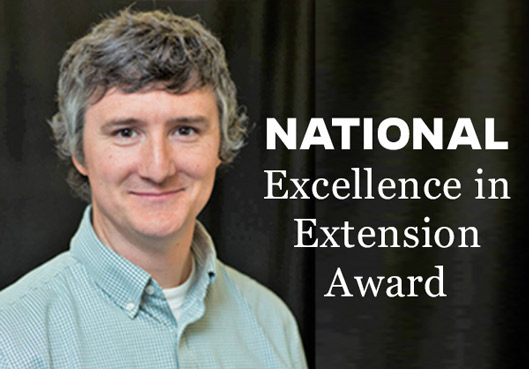
ABOVE: Congratulations to Dr. Jamie Ellis! He won the NATIONAL 2020 Excellence in Extension Award. Read the full USDA press release; IFAS Blog here. Photo by UF/IFAS.

CALL for applicants! The 2020 CAMTech request for applications (RFA) has been released with a deadline of December 1st 2020. They are currently accepting one-page pre-proposals on pre-competitive research related to arthropods and nematodes. This RFA is open to UF and University of Kentucky researchers only. For more information, contact camtech@ifas.ufl.edu.

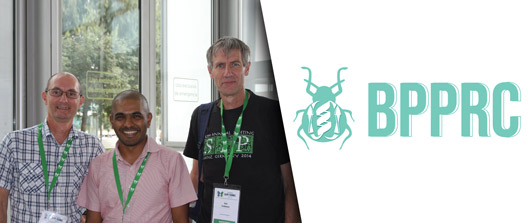
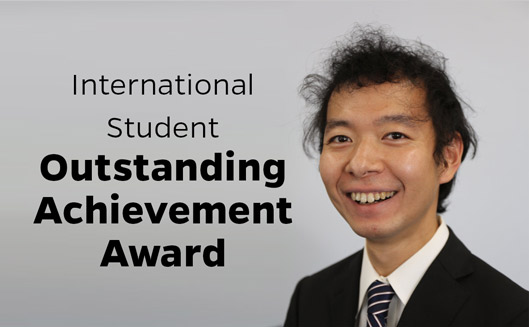
ABOVE: Congratulations to Ph.D. student Shinichi Nakahara on being awarded the CALS International Student Outstanding Achievement Award! Photo provided by UF/CALS.

Alumni Benjamin Waldo (M.S. and D.P.M. with Dr. Billy Crow) has accepted a post-doc position with the USDA in Charleston, South Carolina. Benjamin will be working with the guava root-knot nematode, Meloidogyne enterolobii. Congratulations Benjamin!

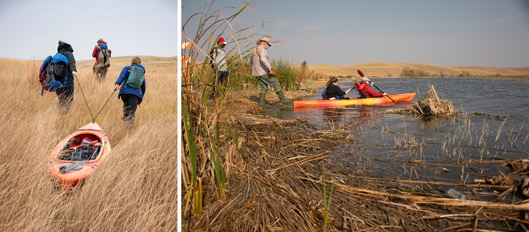
ABOVE: During early October Ph.D. student, Katie Gattoni, and Postdoctoral researcher, Eli Gendron, (members of the Porazinska lab) drove to the Western Nebraska Sandhills to join the 2nd year sampling campaign of the University of Nebraska Collaborative Initiative – “Adapt or Die: The edge of life in the extreme environments of the Western Nebraska Alkaline Lakes”. Katie and Eli collected water and sediment samples as well as soil samples from the shorelines and prairies surrounding 5 different lakes ranging in alkalinity. This multidisciplinary project aims to better understand the ecological and geochemical processes operating in the Alkaline Lakes Region. To obtain a wider geographic range of sediment samples from deeper parts of the lakes, they used a kayak and a soil dredge this year. The teams of Dr. Tom Powers (nematology) and Dr. David Dunigan (virology) at the University of Nebraska organized the trip, helped to drag the kayak across miles of prairie, and assisted with collections of shoreline and soils samples. Their goal is to examine how nematode and microbial communities assemble in these extremely alkaline environments.
Need to name that bug? A host of experts are available to help Floridians identify any insect or related arthropod. If a mystery creature has six or more legs, the UF Insect ID Lab is the place to call.
Dr. Andrei Sourakov photographed this echo moth caterpillar, Seirarctia echo, feeding on coontie. This is also one of the few caterpillars that feeds on king sago, Cycas revoluta. Other hosts include Sabal palmetto, croton, persimmon, and oak.
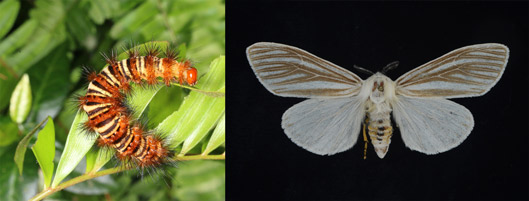
ABOVE:
From left to right: echo moth caterpillar and echo moth adult, Seirarctia echo. Photos by Andrei Sourakov and Lyle Buss.
If you need insect images for a publication or presentation for your UF/IFAS Extension or teaching work, you can go to this direct link, pictures are copyrighted material and intended for official UF use only. Log onto the website using your Gatorlink credentials.
Lyle Buss is the UF/IFAS Insect ID Lab manager.

Think it might be a nematode problem? The Nematode Assay Laboratory serves Florida and other states by providing nematode assays and expert advice regarding nematode management.
For more information on the Nematode Assay Laboratory, please contact the lab manager Dr. Billy Crow.
Canton P, Bonning BC. 2020. Extra oral digestion: Outsourcing the role of the hemipteran midgut. Current Opinion in Insect Science. 41: 86-91. https://doi.org/10.1016/j.cois.2020.07.006
Chen XD, Seo M, Ebert TA, Ashfaq M, Qin W, Stelinski LL. 2020. Hormesis in the brown citrus aphid, Toxoptera citricida (Kirkaldy) (Hemiptera: Aphididae) exposed to sublethal doses of imidacloprid. Florida Entomologist. 103: 337-343. https://doi.org/10.1653/024.103.0305
Crickmore N, Berry C, Panneerselvam S, Mishra R, Connor TR, Bonning BC. 2020. A structure-based nomenclature for Bacillus thuringiensis and other bacteria-derived pesticidal proteins. Journal of Invertebrate Pathology 9: 107438. doi:10.1016/j.jip.2020.107438
Eger J, Pitcher A, Halbert S, Penca C, Hodges A. 2020. First report of Brachyplatys subaeneus (Westwood) (Hemiptera: Heteroptera: Plataspidae) in the United States. Insecta Mundi 0814: 1-6.
El-Desouky A, George J, Sturgeon K, Stelinski LL, Shatters RG. 2020. Asian citrus psyllid adults inoculate huanglongbing bacterium more efficiently than nymphs when this bacterium is acquired by early instar nymphs. Scientific Reports. 10: 18244. https://doi.org/10.1038/s41598-020-75249-5
Hu W, Sommers P, Darcy J, Schmidt S, Porazinska DL. 2020. Multiple-trophic patterns of primary succession following retreat of a high-elevation glacier. Ecosphere. In Press.
Jabanesan A, Mathalaimuthu B, Kalimuthu K, Avery PB. 2020. Impact of Punica granatum-based green larvicide on the predation rate of Polypedates cruciger tadpoles for control of mosquito vectors, Anopheles stephensi and Culex quinquefasciatus (Diptera: Culicidae). International Journal of Tropical Insect Science. 1-11. https://doi.org/10.1007/s42690-020-00293-7
Liu S, Coates BS, Bonning BC. 2020. Endogenous viral elements integrated into the genome of the soybean aphid, Aphis glycines. Insect Biochemistry and Molecular Biology 11: 103405. doi:10.1016/j.ibmb.2020.103405
Liu S, Valencia-Jiménez, A, Darlington M, Vélez AM, Bonning BC. 2020. Diabrotica undecimpunctata virus 2, a novel small RNA virus discovered from southern corn rootworm, Diabrotica undecimpunctata howardi Barber (Coleoptera: Chrysomelidae). Microbiology Resource Announcements. 9: e00380-20. doi:10.1128/MRA.00380-20
Liu S, Valencia-Jiménez A, Darlington M, Vélez, AM, Bonning BC. 2020. Genome sequence of a small RNA virus of the southern corn rootworm, Diabrotica undecimpunctata howardi Barber (Coleoptera: Chrysomelidae). Microbiology Resource Announcements. 9: e00379-20. doi:10.1128/MRA.00379-20
Martini X, Hughes MA, Conover D, Smith J. 2020. Use of semiochemicals for the management of the redbay ambrosia beetle. Insects. 11: 796.
Martini X, Hoyte A, Mafra-Neto A, Aksenov AA, Davis CE, Stelinski LL. 2020. Progress toward an attract-and-kill device for Asian citrus psyllid (Hemiptera: Liviidae) using volatile signatures of citrus infected with huanglongbing as the attractant. Journal of Insect Science. 20: 25.
de Mesquita CP, Brigham LM, Sommers P, Porazinska DL, Farrer EC, Darcy JL, Suding KN, Schmidt SK. 2020. Evidence for phosphorus limitation in high-elevation unvegetated soils, Niwot Ridge, Colorado. Biogeochemistry. 2020. 147: 1-3.
Mizumoto N, Rizo A, Pratt SC and Chouvenc T. 2020. Termite males enhance mating encounters by changing speed according to density. Journal of Animal Ecology. 89: 2542-2552. https://doi.org/10.1111/1365-2656.13320
Mou DF, Humphries AR, Soto N, Helmick EE, Ascunce MS, Goss EM, Bahder BW. 2020. A survey of auchenorrhynchan insects for identification of potential vectors of the 16SrIVE-D phytoplasma in Florida. Florida Entomologist 103: 344-352. https://doi.org/10.1653/024.103.0306
Mou DF, Lee CC, Hahn PG, Soto N, Humphries AR, Helmick EE, Bahder BW. 2020. Effects of lethal bronzing disease, palm height, and temperature on abundance and monitoring of Haplaxius crudus. Insects 11: 748. https://doi.org/10.3390/insects11110748
Short CA, Hatle JD, Hahn DA. 2020. Protein Stores Regulate When Reproductive Displays Begin in the Male Caribbean Fruit Fly. Frontiers in Physiology. 11: 991. https://dx.doi.org/10.3389%2Ffphys.2020.00991
Sloyer, K.E. and Burkett, N.D. 2020. Development and field evaluation of a motion sensor activated suction trap to study vector-host interactions. Methods in Ecology and Evolution. 00: 1-8. https://doi.org/10.1111/2041-210X.13500
Sommer P, Porazinska DL, Darcy JL, Gendron EMS, Vimercati L, Solon AJ, Schmidt S. Microbial species-area relationships in Antarctic cryoconite holes depend on productivity. Microorganisms. In Press.
Traczyk E, Funderburk J, Martini X. 2020. Foraging Behavior Responses of Orius insidiosus (Hemiptera: Anthocoridae) to Thrips Cues. Entomologia Experimentalis et Applicata. 168: 716-722.
Zawierucha K, Porazinska DL, Ficetola GF, Ambrosini R, Baccolo G, Buda J, Ceballos JL, Devetter M, Dial R, Franzetti A, Fuglewicz U. 2020. A hole in the nematosphere: tardigrades and rotifers dominate the cryoconite hole environment, whereas nematodes are missing. Journal of Zoology. 00: 1-19.

New on Featured Creatures:
A Bombardier beetle, Pheropsophus aequinoctialis: Written by Gregory Parrow and Dr. Adam Dale.
Do you have a favorite creature? Learn how to make it into a Featured Creatures!
Dr. James P. Cuda was invited to speak at the 2020 Virtual Aquatic Weed Control Short Course held on October 28th to the 30th. Dr. Cuda recorded and delivered a presentation titled, “Hydrilla IPM: A Proven Concept” that was co-authored by former department faculty Dr. Emma Weeks and Dr. Jennifer Gillett-Kaufman. Over 300 people participated in the short course.

Dr. Billy Crow presented “Effectively managing nematodes, 2020” as part of the Sunshine Webinar Series for golf course superintendents in California on September 10th.
Dr. Billy Crow presented “Lance nematodes on ultradwarf bermudagrass” as part of the virtual IFAS Turfgrass Research Forum on October 14th.

Erick J. Rodriguez, graduate student in the Branham lab, participated in the virtual 10th Meeting of Tephritid Workers of The Western Hemisphere “Americas Congress on Fruit Flies”, held from November 2nd to the 6th. Rodriguez co-authored a talk titled “Morphological Diagnostic Characteristics for Larvae of Pest Fruit Fly Genera.” The meeting was organized by the Colombian Agricultural and Livestock Institute (ICA) and the Tephritid Workers of The Western Hemisphere.
Erick J. Rodriguez co-organized and moderated the Biology, Taxonomy, Mass Rearing, and Control of Fruit Flies International Webinar for the Peruvian Entomological Society.
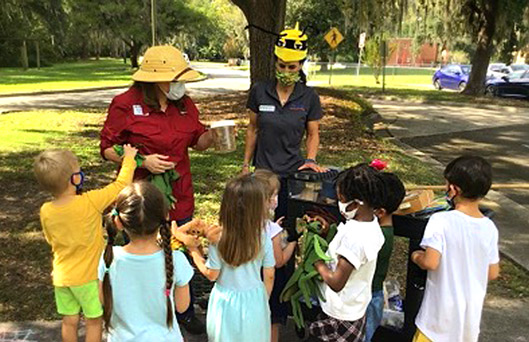
ABOVE: Visit to the Baby Gators on October 28th. Photo by Sharon Williams.
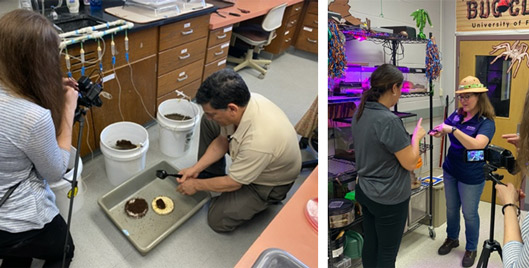
ABOVE: Dr. Roberto M. Pereira and Dr. Rebecca Baldwin being filmed for the 4-H AgVentures video on October 15th. Photos by J. Standley.
Recent Outreach events:
October 9th – NATL Adventure with Bugs for ENY1001, Dr. Baldwin’s Bugs and People course had a great turn out. There were socially distanced stations to view live arthropods & honey bees, and they learned all about our favorite native creatures, sample insect cuisine, and tasted honey.
October 14th – UF Entomology and Nematology Major/Minor/Certificate Information FAIR with Dr. Baldwin, Sarah Tafel, and Jennifer Standley.
October 15th – Duval County 4-H Extension filmed the department and interviewed Dr. Baldwin, Dr. Roberto M. Pereira , and Jennifer Standley for an AgVentures Virtual Tour.
October 20th – Nighttime Outreach Collection Trip to the Santa Fe River with the stupendous Undergraduate Entomology Club, Dr. Baldwin, and Jennifer Standley. It was a blast collecting so many things and hanging out with everyone!
October 28th – Baby Gators were visited by Dr. Baldwin and Jennifer Standley. The littles learned so much about insects and were adorable.
November 14th – Virtual Bug Fest, hosted by the Undergraduate Entomology Club and there is a terrific lineup of things to learn about (live bee demo, origami, pinning techniques, insect care, and more).
November 14th – Jacksonville Garden Club is hosting an event to educate youth on the importance of “bugs.”
Upcoming Outreach events:
November 21st – Girl Scouts of West FL will be having a virtual presentation on meeting an entomologist so they can earn their “bug” badges.

The Outreach Program has a live Arthropod Petting Zoo! The zoo features tarantulas, scorpions, vinegaroons, bess beetles, Madagascar hissing cockroaches, and seasonal insects that are native to north central Florida. If you plan to lead an outreach event (in-person or virtually) and would like to check-out the Arthropod Zoo, please contact the Outreach Coordinator to schedule a short training session. The critters are always popular with both youth and adults. Our arthropods are an invaluable tool that makes STEM disciplines accessible to the public. The arthropods travel in large plexiglass cages which can also be used for viewing. If you are interested in our native orb weaver spiders, you can use one of our travel cages or view it in the larger static cage. We also have activity kits and lesson plans available. Please be sure to contact us and review the protocol on transportation and handling of the animals. If you lead an outreach event, fill out a documentation form to log your event with the outreach program and we will include it in the newsletter. Graduate students that volunteer and attend outreach events have access to ENSO travel grants.
Getting social!
Use #UFBugs so our department can find and share your social posts easily!
Entomology 2020 - ESA’s Virtual Annual Meeting is November 11th to the 25th! The conference will host live-stream content November 16th to the 19th. Registration opens September 1st. For more information, visit https://www.entsoc.org/events/annual-meeting
Want to stay up to date? Check out our website home page for a link to our Google calendar.
Suzy Rodriguez is the newsletter editor and does the HTML coding. Newsletters usually are published around mid-month. Submit items for an issue by the seventh of the month.
We like to share news when it happens using our social media outlets: Twitter, Facebook and YouTube. Follow us on these sites for daily updates! When you send news, we will post it on one or more of these sites and again in the monthly newsletter. Please be sure you have permission from people in photographs you submit for publication.
UF-Bugnews-L listserv subscribers receive notices when issues are posted. Our home page has instructions for subscribing and unsubscribing.
Special thanks to James Brown and Nancy Sanders for reviewing the newsletter for errors, and to Jane Medley and Don Wasik for webpage build and design.
Give Back
Want to support the UF Entomology & Nematology Department? Consider making an online gift today! Questions can be directed to Cody Helmer at (352) 392-1975 or chelmer@ufl.edu.